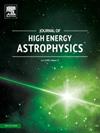Numerical studies of (in)stabilities of shocks in perturbed advective flows around black holes
IF 10.5
4区 物理与天体物理
Q1 ASTRONOMY & ASTROPHYSICS
引用次数: 0
Abstract
Using two-dimensional hydrodynamic simulations, we investigate the stability of shocked accretion flows around black holes under non-axisymmetric perturbations. By systematically exploring the parameter space of specific energy and angular momentum that permits shock formation in advective accretion flows, we demonstrate that quasi-periodic oscillations (QPOs) naturally emerge in perturbed systems. Our spectral analysis reveals characteristic QPO frequencies spanning 0.44-146.57Hz, effectively bridging the observed low-frequency (LFQPOs) and high-frequency QPOs (HFQPOs) in black hole X-ray binaries. The quality factors () of these oscillations range from 1.66 to 203.58, with multiple Lorentzian components indicating distinct oscillation modes. Through wavelet analysis and cross-validation with recent observations (e.g., Swift J1727.8-1613 and GX 339-4), we establish that shock instabilities driven by acoustic wave interactions between the non-axisymmetric perturbation and the shock location can quantitatively explain the temporal features observed in accreting black hole systems. Furthermore, we characterize the γ-dependence of shock morphology, showing that increasing the adiabatic index from 4/3 to 1.4 changes shock positions outward while maintaining oscillation coherence.
黑洞周围扰动平流激波稳定性的数值研究
利用二维流体力学模拟,研究了非轴对称扰动下黑洞周围激波吸积流动的稳定性。通过系统地探索允许平流吸积流激波形成的比能量和角动量的参数空间,我们证明了准周期振荡(QPOs)在摄动系统中自然出现。我们的光谱分析显示,黑洞x射线双星的特征QPO频率跨越0.44-146.57Hz,有效地桥接了观测到的低频(LFQPOs)和高频QPOs (HFQPOs)。这些振荡的质量因子(Q=μ0/2Δ)范围为1.66 ~ 203.58,多个洛伦兹分量表示不同的振荡模式。通过小波分析和与近期观测(如Swift J1727.8-1613和GX 339-4)的交叉验证,我们建立了由非轴对称扰动和激波位置之间的声波相互作用驱动的激波不稳定性可以定量解释在吸积黑洞系统中观测到的时间特征。此外,我们表征了激波形态的γ依赖性,表明将绝热指数从4/3增加到1.4,在保持振荡相干性的同时,激波位置向外改变。
本文章由计算机程序翻译,如有差异,请以英文原文为准。
求助全文
约1分钟内获得全文
求助全文
来源期刊

Journal of High Energy Astrophysics
Earth and Planetary Sciences-Space and Planetary Science
CiteScore
9.70
自引率
5.30%
发文量
38
审稿时长
65 days
期刊介绍:
The journal welcomes manuscripts on theoretical models, simulations, and observations of highly energetic astrophysical objects both in our Galaxy and beyond. Among those, black holes at all scales, neutron stars, pulsars and their nebula, binaries, novae and supernovae, their remnants, active galaxies, and clusters are just a few examples. The journal will consider research across the whole electromagnetic spectrum, as well as research using various messengers, such as gravitational waves or neutrinos. Effects of high-energy phenomena on cosmology and star-formation, results from dedicated surveys expanding the knowledge of extreme environments, and astrophysical implications of dark matter are also welcomed topics.
 求助内容:
求助内容: 应助结果提醒方式:
应助结果提醒方式:


